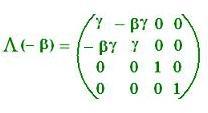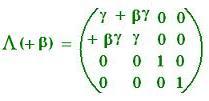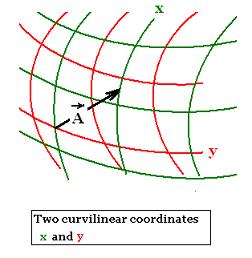General Relativity
© The scientific sentence. 2010
| Relativity: Contravariant and covariant transforms
1. Lorentz Transformations Matrices
From the reference frame at rest (RF):
The velocity of the reference frame (RF) is 0
The velocity of the moving reference frame (MF) is v
The velocity of the moving object is u.
From the moving frame (MF):
The velocity of the moving reference frame (MF) is 0
The velocity of the reference frame (RF) is - v
The velocity of the moving object is u'
In the (MF):, Lorentz Transformations give:

ct' = γ(ct - βx)
x' = γ(x - β ct)
y' = y
z' = z
The contravariant 4-Vector V'(ct',x',y',z') is the transformed of he
contravariant 4-Vector V(ct,x,y,z) by:
V' = Λ(- β) V
In the (RF), Lorentz Transformations give:

ct = γ(ct' + βx')
x = γ(x' + β ct')
y = y'
z = z'
The covariant 4-Vector V(ct,x,y,z) is the transformed of he
covariant 4-Vector V(ct',x',y',z') by:
V = Λ(+β) V'
where
γ = 1/[1 - β2]1/2, and
β = v/c
2. Contravariant Lorentz transformation
We have:
ct' = γ(ct - βx)
x' = γ(x - β ct)
y' = y
z' = z
Taking partial derivatives gives:
∂(ct')/∂(ct) = γ
∂(ct')/∂(x) = - γ β
∂(ct')/∂(y) = 0
∂(ct')/∂(z) = 0
|
∂(x')/∂(ct) = - γ β
∂(x')/∂(x) = γ
∂(x')/∂(y) = 0
∂(x')/∂(z) = 0
|
∂(y')/∂(ct) = 0
∂(y')/∂(x) = 0
∂(y')/∂(y) = 1
∂(y')/∂(z) = 0
|
∂(z')/∂(ct) = 0
∂(z')/∂(x) = 0
∂(z')/∂(y) = 0
∂(z')/∂(z) = 1
|
Therefore, the components of the matrix Λ(-β) are:
Λ(-β)00 = γ = ∂(ct')/∂(ct)
Λ(-β)01 = - γ β = ∂(ct')/∂(x)
Λ(-β)10 = - γ β = ∂(x')/∂(ct)
Λ(-β)11 = γ = ∂(x')/∂(x)
Λ(-β)22 = γ = ∂(y')/∂(y)
Λ(-β)33 = γ = ∂(z')/∂(z)
...
The others are zero.
If we denote by xi the contravariant components of V(ct,x,y,z)
and by yi the contravariant component of V'(ct',x',y',z'), we
can write the components of the matrix Λ(-β) as the following:
Λ(-β)ij = ∂(yi)/∂(xj)
i = 0,1,2,3 stands for line and j = 0,1,2,3 stands for column.
Therefore:
y0 = ΣΛ(-β)0j x0
y1 = ΣΛ(-β)1j x1
y2 = ΣΛ(-β)2j x2
y3 = ΣΛ(-β)3j x3
or:
yi = ΣΛ(-β)ij xi
= Σ ∂(yi)/∂(xj) xi
or
V'i = Σ ∂(yi)/∂(xj) Vi
or
Vi(in the frame y) = Σ ∂(yi)/∂(xj) Vi(in the frame x)
Vi(y) = Σ ∂(yi)/∂(xj) Vi(x)
Using the Einstein summation convention (not writing the symbol Σ), we can write
Vμ(y) = (∂yμ/∂xν) Vν(x)
3. Covariant Lorentz transformation
WE have:
ct = γ(ct' + βx')
x = γ(x' + β ct')
y = y'
z = z'
Taking partial derivatives gives:
∂(ct)/∂(ct') = γ
∂(ct)/∂(x') = + γ β
∂(ct)/∂(y') = 0
∂(ct)/∂(z') = 0
|
∂(x)/∂(ct') = + γ β
∂(x)/∂(x') = γ
∂(x)/∂(y') = 0
∂(x)/∂(z') = 0
|
∂(y)/∂(ct') = 0
∂(y)/∂(x') = 0
∂(y)/∂(y') = 1
∂(y)/∂(z') = 0
|
∂(z)/∂(ct') = 0
∂(z)/∂(x') = 0
∂(z)/∂(y') = 0
∂(z)/∂(z') = 1
|
Therefore, the components of the matrix Λ(+β) are:
Λ(+β)00 = γ = ∂(ct)/∂(ct')
Λ(+β)01 = γ β = ∂(ct)/∂(x')
Λ(+β)10 = γ β = ∂(x)/∂(ct')
Λ(+β)11 = γ = ∂(x)/∂(x')
Λ(+β)22 = γ = ∂(y)/∂(y')
Λ(+β)33 = γ = ∂(z)/∂(z')
...
The others are zero.
If we denote by xi the covariant components of V(ct,x,y,z)
and by yi the contravariant component of V'(ct',x',y',z'), we
can write the components of the matrix Λ(+β) as the following:
Λ(+β)ij = ∂(xi)/∂(yj)
i = 0,1,2,3 stands for line and j = 0,1,2,3 stands for column.
Therefore:
x0 = ΣΛ(+β)0j y0
x1 = ΣΛ(+β)1j y1
x2 = ΣΛ(+β)2j y2
x3 = ΣΛ(+β)3j y3
or:
xi = ΣΛ(+β)ij xi
= Σ ∂(xi)/∂(yj) xi
or
V'i = Σ ∂(xi)/∂(yj) Vi
or
Vi(in the frame x) = Σ ∂(xi)/∂(yj) Vi(in the frame y)
Vi(x) = Σ ∂(xi)/∂(yj) Vi(y)
Using the Einstein summation convention (not writing the symbol Σ), we can write:
Vμ(x) = ∂(xμ/∂yν) Vν(y)
4. Contravariant and covariant transform: General case

If a vector A(x) has the contravariant components xμ in the curvilinear reference frame "x", its transformed contravariant vector A(y) in the curvilinear reference frame "y"
has the components yν.
If A(x) is a scalar such as temperature, its related magnitude remains the same A(x) = A(y)
If A(x) is a vector, a little displacement dA(x) of A(x)
in the coordinate reference frame "x" involves its related transformed displacement dA(y) of the transformed A(y) in the coordinate reference frame "y".
That is the displacements of the components dxμof dA(x) in the coordinate reference frame "x" involve dyν in the coordinate reference frame "y".
We can write the following total differential:
dA(x) = Σ (ν) (∂ A(x)/∂xμ) dxν =
(∂ A(x)/∂xμ) dxν
and
dA(y) = Σ (ν) (∂ A(y)/∂yμ) dxν =
(∂ A(y)/∂yμ) dyν
The transformed contravariant components of dA(y) are:
dyμ = Σ(ν)(∂ yμ)/∂xν) dxν =
(∂ yμ)/∂xν) dxν
The transformed contravariant components of A(y) are:
yμ = Σ(ν)(∂ yμ)/∂xν) xν =
(∂ yμ)/∂xν) xν
Therefore:
The transformed contravariant vector Aμ(y) is written as:
Aμ(y) = (∂ yμ)/∂xν) Aν(x)
Similarly;
The transformed covariant vector Aν(x) is written as:
Aν(x) = (∂ xν)/∂yμ) Aμ(y)
Aμ(y) = (∂yμ/∂xν) Aν(x)
Aν(x) = (∂xν/∂yμ) Aμ(y)
|
|